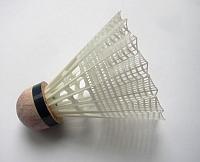Shuttlecock
Shuttlecock, also known as a bird or birdie, is a high-drag projectile used in the sport of badminton. It has an open conical shape formed by feathers (or a synthetic alternative) embedded into a rounded cork (or rubber) base. The shuttlecock's unique aerodynamic properties allow it to fly differently from the balls used in most racquet sports; it flies with the cork forward and is aerodynamically stabilized by the feathers or synthetic skirt.
History[edit | edit source]
The game of badminton evolved from earlier games, with the shuttlecock being a central element for centuries. Its origins can be traced back to ancient civilizations in Europe and Asia, with a form of the game being played in Ancient Greece, China, and India. The modern game of badminton began in the mid-19th century among the British as a variant of the earlier game of battledore and shuttlecock.
Construction[edit | edit source]
A traditional shuttlecock is made of 16 feathers from the left wing of a goose or a duck and is embedded into a cork base covered in a thin layer of leather. The feathers are arranged in a circular fashion, creating a cone shape that is approximately 62 to 70 mm in diameter at its wider part and 85 to 92 mm in length. The cork is hard and rounded, making it fit for striking with racquets. In competitive badminton, shuttlecocks are graded according to their speed.
Synthetic shuttlecocks, made of nylon or other plastics, are also widely used, especially by recreational players and in regions where the use of feathered shuttlecocks is not economical. These synthetic versions mimic the flight characteristics of feathered ones to a degree but are more durable and less susceptible to damage.
Aerodynamics[edit | edit source]
The shuttlecock's design allows it to fly with stability and decelerate rapidly after being hit. Unlike a ball, the shuttlecock is feathered so that it presents significant drag, causing it to slow down more quickly than a ball. This high drag makes the shuttlecock more affected by wind, which is why badminton is traditionally played indoors.
Regulations[edit | edit source]
The Badminton World Federation (BWF) sets the standards for shuttlecock construction and use in official competitions. According to BWF regulations, the shuttlecock should weigh between 4.74 to 5.50 grams. The diameter of the cork base should be between 25 to 28 mm, and the diameter of the circle that the feathers make should be between 58 to 68 mm.
Cultural Significance[edit | edit source]
In addition to its role in badminton, the shuttlecock has cultural significance in several countries. It is used in traditional games and celebrations, particularly in Asia. For example, the Chinese game jianzi involves players keeping a heavily weighted shuttlecock in the air using their feet.
Environmental Considerations[edit | edit source]
The production of feathered shuttlecocks has raised concerns regarding animal welfare and environmental sustainability. The sourcing of feathers, primarily from geese and ducks, has led to discussions about ethical sourcing and the impact on these bird populations. Synthetic shuttlecocks offer an alternative that is more environmentally friendly and animal-friendly, though debates about their performance compared to feathered shuttlecocks continue.
Search WikiMD
Ad.Tired of being Overweight? Try W8MD's physician weight loss program.
Semaglutide (Ozempic / Wegovy and Tirzepatide (Mounjaro / Zepbound) available.
Advertise on WikiMD
|
WikiMD's Wellness Encyclopedia |
| Let Food Be Thy Medicine Medicine Thy Food - Hippocrates |
Translate this page: - East Asian
中文,
日本,
한국어,
South Asian
हिन्दी,
தமிழ்,
తెలుగు,
Urdu,
ಕನ್ನಡ,
Southeast Asian
Indonesian,
Vietnamese,
Thai,
မြန်မာဘာသာ,
বাংলা
European
español,
Deutsch,
français,
Greek,
português do Brasil,
polski,
română,
русский,
Nederlands,
norsk,
svenska,
suomi,
Italian
Middle Eastern & African
عربى,
Turkish,
Persian,
Hebrew,
Afrikaans,
isiZulu,
Kiswahili,
Other
Bulgarian,
Hungarian,
Czech,
Swedish,
മലയാളം,
मराठी,
ਪੰਜਾਬੀ,
ગુજરાતી,
Portuguese,
Ukrainian
Medical Disclaimer: WikiMD is not a substitute for professional medical advice. The information on WikiMD is provided as an information resource only, may be incorrect, outdated or misleading, and is not to be used or relied on for any diagnostic or treatment purposes. Please consult your health care provider before making any healthcare decisions or for guidance about a specific medical condition. WikiMD expressly disclaims responsibility, and shall have no liability, for any damages, loss, injury, or liability whatsoever suffered as a result of your reliance on the information contained in this site. By visiting this site you agree to the foregoing terms and conditions, which may from time to time be changed or supplemented by WikiMD. If you do not agree to the foregoing terms and conditions, you should not enter or use this site. See full disclaimer.
Credits:Most images are courtesy of Wikimedia commons, and templates, categories Wikipedia, licensed under CC BY SA or similar.
Contributors: Prab R. Tumpati, MD



